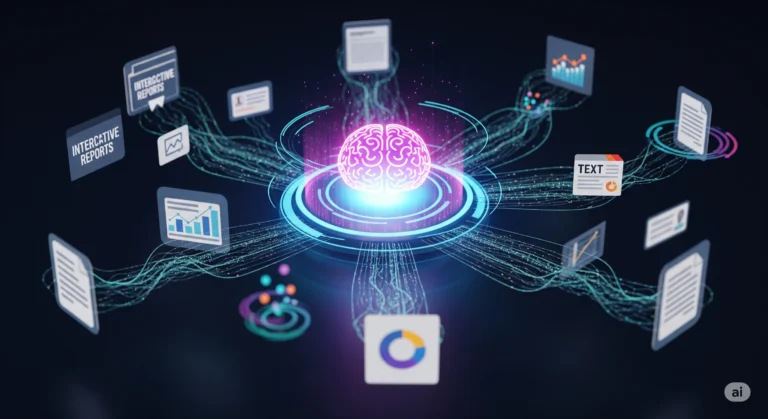Customer support teams are drowning in a sea of tickets. And let’s be honest—responding gives you a deep sense of productivity? Not quite. According to recent data, AI customer support automation can cut ticket volume by up to six zero percent—a staggering statistic that speaks to a solution that is not just trendy but transformational.
But it’s more than just cutting down on tickets. AI Customer Support Automation It’s about creating a support system that never sleeps, one that provides immediate value to customers while freeing up human agents to focus on complex and truly valuable tasks.
In this article, you will discover how to craft your own 24/7 AI Customer Support Automation, implement it step by step, and measure its success. We’ll focus on each phase, including tools, resources, and even the pitfalls to avoid so you can get the consistent, measurable ROI your business needs.
However, before diving into the nitty-gritty, let’s frame this strategic approach so you understand not just the what, but also the why and how.
The Strategic Toolkit
Implementing artificial intelligence in customer support is common. The key challenge is doing it effectively. The foundation rests on five pillars:
1. Strategic Foundation
First, you must understand the audience you serve. Have conversations. Read your customer service logs. Identify top support issues. Then, align that data with broader business goals—like up-selling, cross-selling, increasing customer lifetime value, or just improving satisfaction.
2. AI-Powered Tools
Selecting the right solution is crucial. Experiment with a few AI tools and take advantage of available demos. Here are some solid ones that will work with AI Customer Support Automation:
Chatfuel: A chatbot framework especially powerful for Telegram and Facebook Messenger. Chatfuel, though it can be used for simple AI customer support automation, requires significant configuration to integrate with knowledge bases—check out our content strategy guide to map this process.
Intercom: An AI helpdesk platform with built-in automation for routing tickets, answering FAQs, and live chat integration. Intercom offers a one-click setup for many standard use cases, making it a strong candidate for reducing ticket volume.
Zendesk: An excellent option for those seeking an enterprise-grade AI helpdesk. Zendesk‘s AI capabilities mean you can structure data for deep learning, especially if you’re a larger organization. The AI support automation market is growing, so these tools must evolve, and Zendesk delivers.
3. Human Expertise
An AI Customer Support Automation is nothing without a knowledge-rich, easily accessible human touch for escalation and complex decision-making. Ensure whatever AI you deploy has a clear path to trigger human handoff.
Time & Resource Investment
Let’s talk cost. Without proper metrics, your support automation isn’t just a project—it’s an investment. The good news is the numbers speak for themselves:
Manual Method: A typical support ticket takes 5-7 minutes to resolve. Multiply that by hundreds or thousands per day, and you have a high operational cost and low customer satisfaction. Human agents are valuable. If each earns $20/hr, $100/hr is a base, but overtime, exhaustion, and high turnover are real costs. The headache and the bill require a change.
AI Customer Support Automation Powered Method: Let’s say 30% of support tickets fill with the same questions (password resets, account lookups). An AI agent effectively handles these immediately. Each ticket is resolved in under 30 seconds. Let’s compute the savings:
- Time saved: 1 to 2 agents dedicated full-time to task could save 8 hours per day. 60% reduces the queue volume.
This translates to an ROI calculation that reduces operational costs by approximately 30% in the first year.
The Implementation Blueprint
Ready to make the shift? Implementation can feel daunting, but when broken down, it’s manageable. Follow these steps:
Step 1: Export Your Knowledge Base
Take all your current FAQs, product descriptions, knowledge base articles, or manual processes and transfer them into a structured database that the AI can access. The better the data, the smoother the answers.
Step 2: Choose Your AI Platform
Based on your analysis (above), pick one of the AI tools mentioned or a new one you trust, and integrate your knowledge base through an API, SDK, or direct import.
Step 3: Train Your AI Agent
Use machine learning to train the AI agent. Start with the most common questions. Run simulations. Provide example inputs and expected outputs. Most tools offer training wizards.
Step 4: Implement 24/7 Availability
Set channels up. This usually starts with a website chatbot but can become SMS, Telegram, WhatsApp, Voice – however you need to speak to your customers.
Step 5: Test and Run
Start with beta rollout to a subset of users. Measure performance. Refine the model based on failure and success metrics.
Pro-Tip: Monitor performance daily for the first two weeks. Focus on response accuracy and escalation rates. Adjust your knowledge and AI training accordingly. This step is the foundation for continuous improvement—don’t skip it.
Measuring Success: KPIs & ROI
You can’t manage what you don’t measure. Let’s focus on key metrics that tell you if your AI agent is delivering.
| Metric | What It Tells You |
|---|---|
| Resolution Rate | % of tickets the AI agent resolves alone |
| First Response Time | Average time between user query and bot reply |
| Ticket Volume Reduction | % reduction in the number of tickets staff receive |
| Escalation Rate | % of AI-assisted ticket needing human support |
| Customer Satisfaction (CSAT) | Net sentiment on how users find the bot |
In addition, calculate ROI based on:
- Cost reduction (hour saved per ticket)
- Increased sales (resulting from faster responses and upsell opportunities)
- Employee satisfaction (human agents focus on meaningful work)
Scaling & Advanced Strategies
Once you’ve implemented an AI agent, you can take it to the next level. Consider:
- Natural Language Processing (NLP) Expansion: Use NLP beyond Q&A to detect user sentiment and context to offer proactive solutions.
- Integration with CRM: Enhance user profiles by learning past interactions to offer personalized solutions.
- Self-Learning Mechanism: Implement ongoing AI training using data from successful and failed interactions – think continuous improvement in action.
Strategic Business Applications
When you consider different industries, AI customer support automation strategies need tailoring. Here’s how:
For B2B SaaS
Typically, these businesses deal with complex technical issues, long response times, and high support costs if done incorrectly. Implement an AI Customer Support Automation to boost first-contact resolution and free up engineers.
For E-commerce
In this space, speed and ease matter. An AI Customer Support Automation can resolve returns, answer product questions, and guide purchases 24/7—resulting in fewer tickets at the support tier.
For Digital Agencies
You advise others on customer support, so why not use modern solutions yourself? AI Customer Support Automation Agent can answer clients’ technical support queries and allow teams to focus on high-level strategy.
Related Reading:
Looking to build or train your AI Customer Support Automation Agent effectively? Discover how to maximize your training data. If you’re looking for custom gpt training, read our guide on how to use AI tools such as ChatGPT for customer support. custom gpt training
Common Strategic Pitfalls to Avoid
Even the best strategy can go astray. Here are common mistakes:
- Not Starting Small: Jumping in without a pilot test burns through resources and creates resistance from your team.
- Forgetting Brand Voice: AI doesn’t automatically know “how you say things.” You must train it to understand your tone, if appropriate.
- Metrics Obsession, Customer Experience Neglect: Focus first on being helpful, then you can measure volume and satisfaction.
- Choosing a One-Size-Fits-All AI Without Your Data Layer: Integrating a generic chatbot might not understand your products or services. Context matters.
Building Your Content Engine: Systems & Automation
Think bigger. Don’t stop at a one-off implementation. Embed your AI support automation into a larger content system.
Develop a two-way feedback system:
- Data to Content: Use cases where AI handles tickets to inform your content strategy. What your users ask frequently? Create clear answers and blog posts addressing them.
- Automated Knowledge Base Updates: Teach your AI to pull data from a CMS and use it to update answers autonomously.
This approach creates a self-reinforcing flywheel: satisfied customers generate fewer support tickets, which provides better data for AI training. The system optimizes itself over time.
This makes your support function a driver—not an expense.
Conclusion
AI customer support automation gives you the power to cut ticket volume by up to 60%, providing a sustainable solution to support bottlenecks. This strategy works for multiple industries, offers clear ROI, and frees up your human agents to focus on empathy, trust, and growth. It’s not a quick fix. But the long-term value is undeniable.
Are you sure you want to be without a 24/7 support agent? Find out how to build one tailored to your business in our AI customer support automation platform setup guide.
Frequently Asked Questions
Q1: How much does it cost to implement an AI customer support agent?
Starting costs are moderate. Depending on the AI tool you select for your customer service chatbot, expect to spend a few thousand dollars for integration and training. But think of the ROI: far beyond the initial cost, you’ll save on live agent labor. In many cases, the first year sees a 30% reduction in support spend.
Q2: Can I train a custom AI without technical skills?
With user-friendly platforms like Intercom and Zendesk, yes. They support custom training with wizards and templates. The key is good data. Follow our AI agent customization guide to get started.
Q3: What happens if the AI says something wrong?
Welcome to AI. Rein in the system by monitoring closely early on and escalating exceptions. Any AI model improves with more data. It’s a process, not a one-time download.






